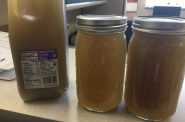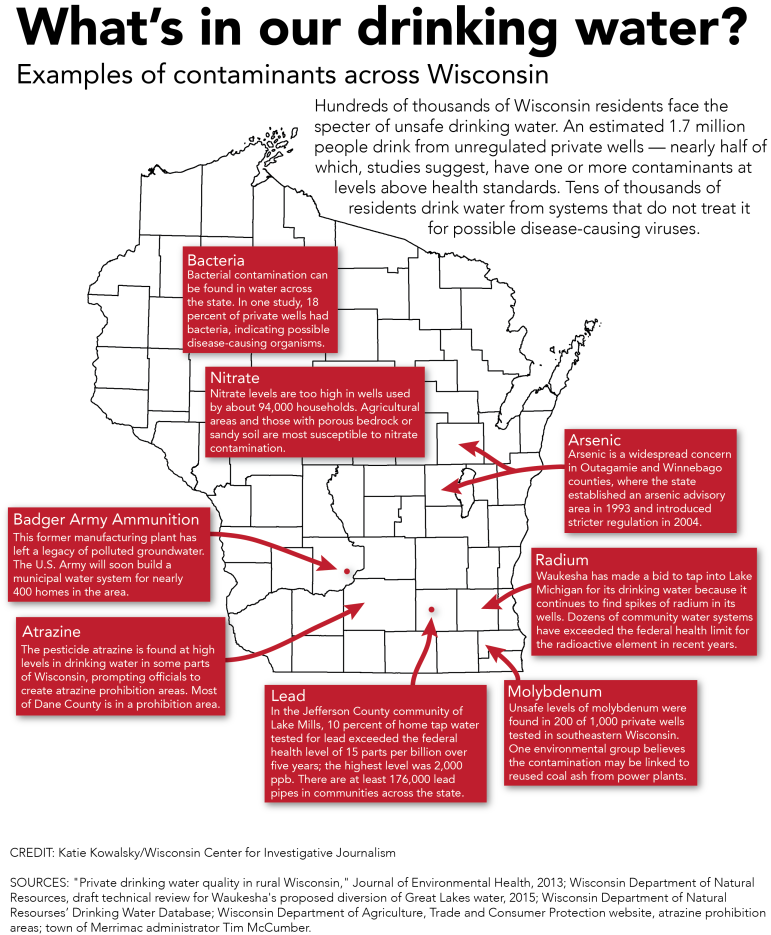Human Waste Pollutes State Drinking Water
Problem often caused by septic systems; Tougher laws needed, experts say.
Landspreading under fire
Enforcement of state laws regulating landspreading of septic waste on farm fields also has come under criticism.
In 2015, a citizen watchdog group called the Dunn County Groundwater Guardian Community found 150 sites on which the state DNR allows spreading of septic waste that were below or near the minimum standard for proper soil percolation, or the rate at which water and contaminants move through the soil. Under state law, fields with soil percolation rates greater than 6 inches per hour cannot be used for landspreading.
Neil Koch, a retired hydrologist who organized the citizen group and developed the map of percolation rates, found that 150 of the 400 sites used for spreading septic waste in Dunn County had rates of 5 to 20 inches per hour. Koch said the DNR also recently told him the agency had failed to notify him of an additional 90 landspreading sites in the county.
In a March letter to Koch, Susan Sylvester, director of the DNR’s Water Quality Bureau, acknowledged that the sites he identified did not meet minimal requirements but said reduced application rates were approved because of a low threat to drinking water. Sylvester said lime is added to the waste to kill pathogens, and exposure to sunlight and heat further reduce the risk.
Sylvester added, however, that the agency is reevaluating septage and other landspreading sites throughout Wisconsin. And she noted that compliance checks in Wood County have prompted an increase in septage being hauled to wastewater treatment plants — an option Koch has identified as an “easy solution” to the problem.
Improper application of septic waste in Dunn County, Koch said, “may be the tip of the iceberg.”
Viruses in water also cause illness
Numerous water experts also say the state is failing to protect Wisconsin residents from human and animal viruses in municipal drinking water supplies — some of it tied to leaky municipal sewer systems. Neither federal nor state rules require municipalities to disinfect drinking water drawn from groundwater, which supplies about two-thirds of the state’s potable water, nor are municipalities required to test for viruses.
Viruses are a relative newcomer to the list of pathogens known to endanger drinking water. But the science behind their presence — and their impact on the health of thousands — is already well-documented.
Researcher and microbiologist Mark Borchardt discovered viruses in Wisconsin groundwater in a series of studies while working for Marshfield Clinic. In 2004, for example, Borchardt found that 50 percent of water samples collected from four La Crosse municipal wells tested positive for disease-causing viruses, including enteroviruses, rotavirus, hepatitis A and norovirus.
During 2006 and 2007, Borchardt looked at 14 Wisconsin communities with populations above 1,300 that did not disinfect their municipal water. Tap water was tested, and 621 households were surveyed to determine if viruses were making families sick.
Among the 1,079 children and 580 adults surveyed, there were 1,843 cases of acute gastrointestinal illness during the study period. Borchardt attributed 6 to 22 percent of the cases to contaminated drinking water. Researchers also found that up to 63 percent of acute gastrointestinal illnesses among children younger than age 5 were likely caused by norovirus in the drinking water.
Subsequent studies showed the source of the viruses to be leaking municipal sewer pipes, according to a UW-Extension article by Madeline Gotkowitz, a hydrogeologist with the Wisconsin Geological and Natural History Survey.
“Many of these sewers date back to the early 1900s,” wrote Gotkowitz, “and they are cracked and leaky. Inward leakage to these pipes often causes overflows at sewage treatment plants during large rainstorms. However, these pipes also leak raw sewage outward and are common sources of groundwater pollution in urban areas, towns and villages.”
The research illustrates the crucial link between maintenance of infrastructure and water quality. The American Society of Civil Engineers estimated in 2013 that it would cost Wisconsin $7.1 billion to adequately maintain and upgrade drinking water systems over the next 20 years. Municipal wastewater treatment updates and repairs alone would cost about $6.4 billion, the group found.
Several years ago, the city of Adams in Adams County replaced its entire water and sewer system. When workers dug up sections of sewer line, they discovered the old clay pipes had disintegrated, city administrator Bob Ellisor told the Wisconsin State Journal in 2009.
“There were some areas where the sewer didn’t exist anymore,” Ellisor said. “The sewage wasn’t really making it to the sewage plant.”
A “relatively simple” way to ensure the safety of water is to disinfect it, Gotkowitz wrote. Yet, the state does not require such treatment — even in the face of Borchardt’s studies.
In 2009, under Democratic Gov. Jim Doyle, the Natural Resources Board passed a rule requiring disinfection of municipal water by 2013. But in 2011, the Republican-controlled Legislature blocked it on a largely party-line vote. As of February, 56 communities in Wisconsin serving nearly 65,000 people did not treat their water for viruses, according to a report published by Wisconsin Public Radio citing DNR figures.
Among the lawmakers who helped block the rule was then-Rep. Erik Severson, R-Star Prairie, a physician. He told the Milwaukee Journal Sentinel that residents would probably prefer occasional sickness to the cost of upgrading municipal water systems.
Todd Ambs, who was the head of the DNR’s Water Division until 2010, recalls being shocked by the decision. Ambs now heads the nonprofit Healing Our Waters-Great Lakes Coalition, which includes more than 100 groups dedicated to restoring the health of the Great Lakes.
Said Ambs: “That may be, to me, the worst piece of legislation that has gone through the Legislature.”
The nonprofit Wisconsin Center for Investigative Journalism (www.WisconsinWatch.org) collaborates with Wisconsin Public Radio, Wisconsin Public Television, other news media and the UW-Madison School of Journalism and Mass Communication. All works created, published, posted or disseminated by the Center do not necessarily reflect the views or opinions of UW-Madison or any of its affiliates.
Article Continues - Pages: 1 2
Tainted Water
-
Fecal Microbes In 60% of Sampled Wells
 Jun 12th, 2017 by Coburn Dukehart
Jun 12th, 2017 by Coburn Dukehart
-
State’s Failures On Lead Pipes
 Jan 15th, 2017 by Cara Lombardo and Dee J. Hall
Jan 15th, 2017 by Cara Lombardo and Dee J. Hall
-
Lax Rules Expose Kids To Lead-Tainted Water
 Dec 19th, 2016 by Cara Lombardo and Dee J. Hall
Dec 19th, 2016 by Cara Lombardo and Dee J. Hall


















Rep Severson should have lost his physicians’ license for a comment like that. He SHOULD know better than most that getting sick from bad water could be deadly for those with compromised immune systems. It happened with the crypto crisis.